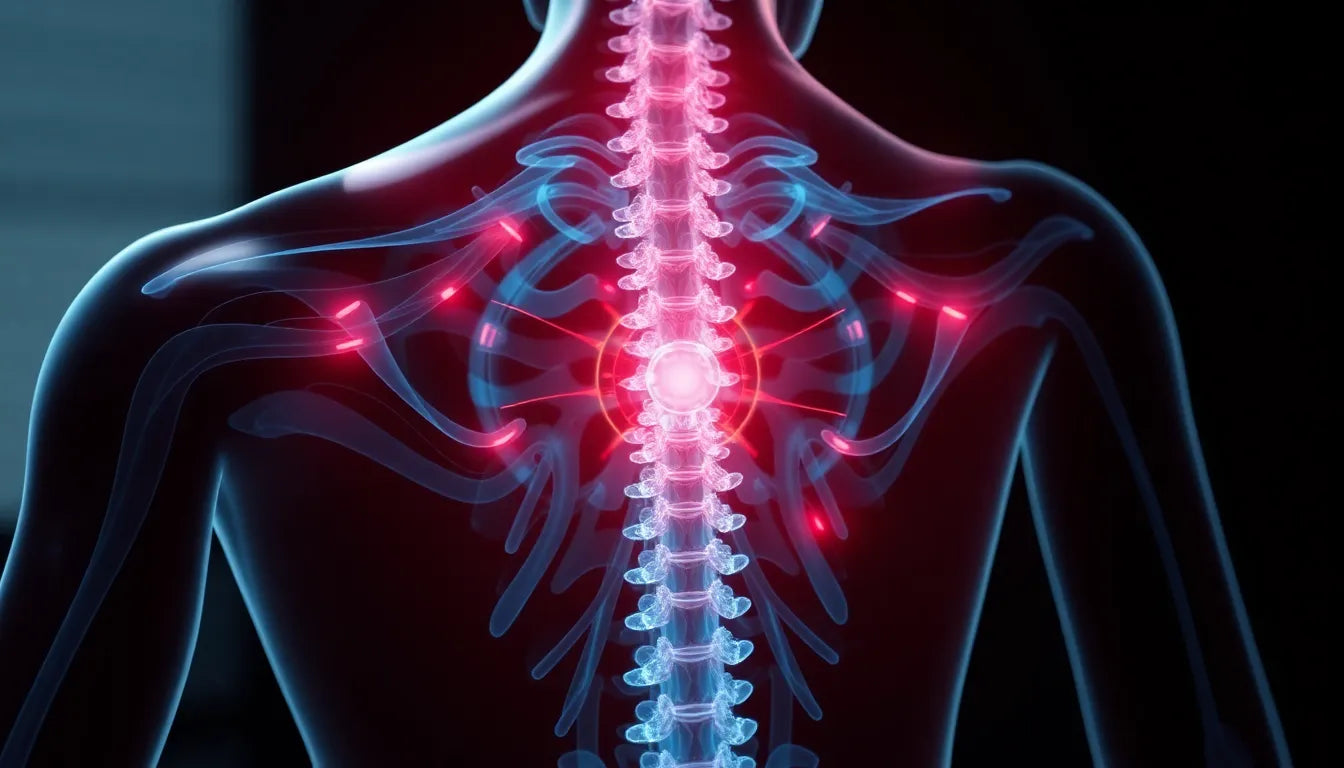Dealing with a herniated disc in the back can be a daunting experience, but understanding the condition is the first step towards effective management. A herniated disc, often referred to as a slipped or ruptured disc, occurs when the soft inner gel of a spinal disc pushes through a tear in the tougher exterior. This can lead to pain, numbness, and weakness, typically affecting the back and extending into the limbs. Common causes include age-related wear and tear, sudden heavy lifting, or even an awkward twist of the spine.
Recognizing the symptoms of a herniated disc
Symptoms of a herniated disc vary depending on the location and severity of the herniation. Most frequently, individuals experience sharp or burning pain in the back, which may radiate down the legs or arms. Some might also notice numbness or tingling in the affected areas, alongside muscle weakness that can impair everyday activities. Early intervention is crucial, as untreated herniated discs can lead to chronic pain and further complications. Hence, recognizing these symptoms and seeking timely medical advice is essential to prevent the condition from worsening.
Embracing non-surgical treatments
For many, the thought of surgery can be daunting, and fortunately, it is not always necessary. Non-surgical treatments are often the first line of defense against herniated discs. These approaches focus on alleviating pain and improving functionality through various lifestyle changes and therapeutic interventions. By adopting certain strategies, individuals can effectively manage their symptoms and enhance their quality of life without undergoing invasive procedures.
Non-surgical management typically involves a combination of rest, physical therapy, and medication. Rest is crucial to avoid activities that might exacerbate pain, while targeted exercises can help strengthen the core muscles and improve posture, both of which are vital in supporting the spine. Over-the-counter pain relievers, such as NSAIDs, can provide significant relief from discomfort. Additionally, physical therapy can play a pivotal role in enhancing mobility and reducing pain through personalized exercise regimens.
The journey to recovery from a herniated disc is unique for each individual, and with the right combination of therapies and lifestyle adjustments, many can find relief without resorting to surgery. In the following sections, we will delve deeper into these non-surgical strategies, offering a comprehensive guide to managing a herniated disc and reclaiming your active lifestyle.
conservative management strategies for herniated discs
When facing a herniated disc, taking a conservative approach can often yield significant relief. One of the first steps involves rest and activity modification. It's crucial to avoid activities that exacerbate pain, such as heavy lifting or prolonged sitting. Instead, focus on gentle movements and positions that promote healing. For instance, lying on your back with a pillow under your knees can help reduce spinal pressure.
Medication also plays a vital role in managing herniated disc symptoms. Over-the-counter pain relievers like nonsteroidal anti-inflammatory drugs (NSAIDs) can help alleviate discomfort. In cases of severe pain, prescription medications may be necessary. However, it's important to use these under the guidance of a healthcare professional to avoid potential side effects and dependency.
Physical therapy stands as a cornerstone of non-surgical treatment. Through targeted exercises, individuals can strengthen core muscles and improve posture, both of which are essential for supporting the spine. A physical therapist can develop a personalized regimen that not only enhances mobility but also reduces pain, allowing for a gradual return to normal activities.
For those whose symptoms persist despite initial treatments, spinal injections may offer relief. Epidural steroid injections and nerve blocks can help reduce inflammation and alleviate pain. While these are generally safe, they do come with potential side effects, so discussing them thoroughly with a healthcare provider is advised.
exploring alternative and complementary therapies
Beyond conventional treatments, alternative and complementary therapies can provide additional support in managing a herniated disc. Lifestyle modifications, such as ergonomic adjustments at home and work, are crucial. Ensuring that your workstation is set up to minimize strain on your back can significantly impact your recovery. Additionally, maintaining a healthy weight is important to reduce pressure on the spine.
Holistic approaches, including yoga, pilates, and massage, can also be beneficial. These therapies not only promote relaxation but also enhance flexibility and strength, which are vital for spinal health. Incorporating mindfulness and relaxation techniques, such as meditation, can further aid in managing pain and stress associated with a herniated disc.
In conclusion, managing a herniated disc without surgery involves a multifaceted approach that combines rest, medication, physical therapy, and lifestyle changes. By embracing both conventional and complementary therapies, individuals can effectively alleviate pain and improve their quality of life. In the next section, we will explore advanced non-surgical interventions and answer common questions about herniated disc management.
Advanced non-surgical interventions for herniated discs
For those seeking additional relief from a herniated disc in the back, advanced non-surgical interventions offer promising options. Among these, spinal decompression therapy stands out as a non-invasive technique designed to alleviate pressure on the affected disc. This therapy involves the use of a motorized traction table that gently stretches the spine, promoting the repositioning of the disc material and improving nutrient exchange to the damaged area. Patients who experience chronic pain or have not found relief through initial conservative treatments may benefit from this approach.
Incorporating ergonomic aids into daily routines can also play a critical role in managing herniated disc pain. Supportive chairs, braces, and specially designed cushions help maintain proper posture and reduce strain on the spine. When selecting ergonomic aids, it is important to consider factors such as adjustability, comfort, and support to ensure they meet individual needs. These tools can significantly enhance recovery and prevent further injury by promoting optimal spinal alignment.
When to consider surgery
While most individuals find relief through non-surgical means, there are cases where surgical intervention becomes necessary. Surgery is typically considered when conservative treatments fail to alleviate symptoms, or if there is significant neurological impairment, such as severe weakness or loss of bladder control. Common surgical options include microdiscectomy, which involves removing the herniated portion of the disc, and laminectomy, which relieves pressure by removing part of the vertebra.
It is crucial to approach surgery as a last resort, and patients should have a thorough discussion with their healthcare provider about the potential benefits and risks. Recovery from surgery varies, but most individuals can expect to resume normal activities within a few weeks to months, depending on the procedure and individual healing rates.
Frequently asked questions
What is the best sleeping position for a herniated disc?
Sleeping positions that reduce spinal strain are crucial for managing a herniated disc. Lying on your back with a pillow under your knees can help maintain the natural curve of the spine. Alternatively, sleeping on your side with a pillow between your knees can also provide relief and support.
Can exercise worsen a herniated disc?
While exercise is beneficial, it is important to avoid movements that exacerbate pain. Engaging in safe, low-impact exercises such as walking, swimming, or cycling can strengthen the muscles supporting the spine. Consulting a physical therapist for personalized guidance ensures exercises are performed safely and effectively.
How long does it take to recover from a herniated disc without surgery?
Recovery time varies depending on the severity of the herniation and adherence to treatment. Most individuals experience significant improvement within a few weeks to a few months. Factors such as overall health, lifestyle, and the effectiveness of the treatment plan influence the healing timeline.
Are there any preventive measures to avoid a herniated disc?
Maintaining spinal health is key to preventing herniated discs. Regular exercise, proper lifting techniques, maintaining a healthy weight, and ensuring ergonomic workspaces can help reduce the risk. Being mindful of posture and avoiding prolonged periods of inactivity are also essential preventive measures.
What role does diet play in managing a herniated disc?
A balanced diet rich in anti-inflammatory foods can support healing and reduce inflammation. Incorporating foods high in omega-3 fatty acids, antioxidants, and vitamins can aid in recovery. Staying hydrated and avoiding processed foods further contributes to overall spinal health.
```html
Sources
- Mayo Clinic. "Herniated Disk – Diagnosis and Treatment."
- Cleveland Clinic. "Herniated Disk (Bulging Disk): Symptoms & Treatment."
- Sciatica.com. "11 Treatment Options for Herniated Discs."
- Dr. Likover. "Treatment Options for a Herniated Disc."
- Cuellar Spine. "Herniated Disc Treatment Options."
- Northeast Spine & Sports. "What Is the Best Treatment for a Herniated Disc?"


















